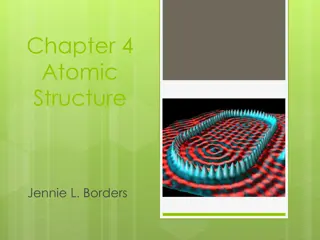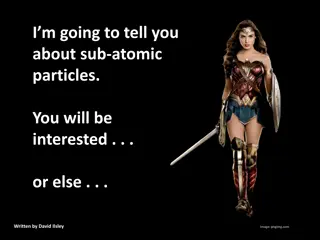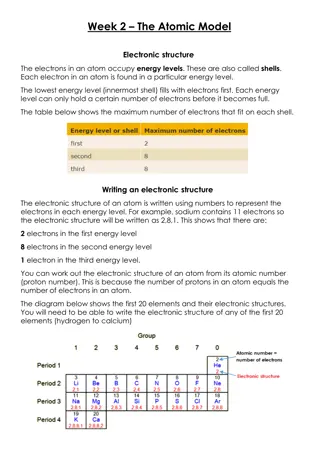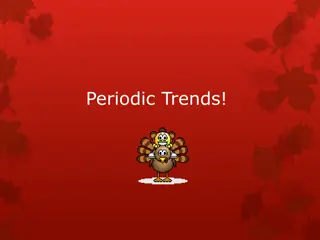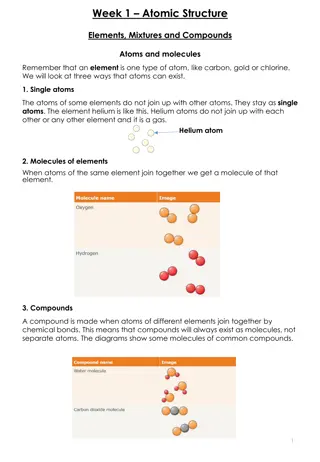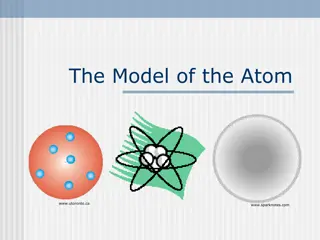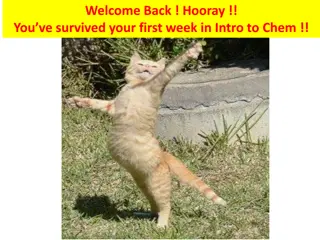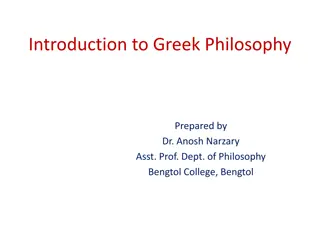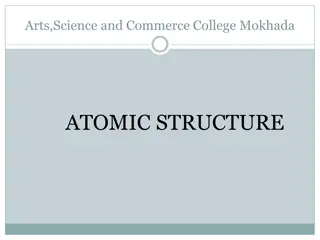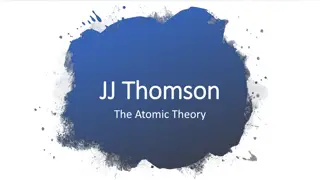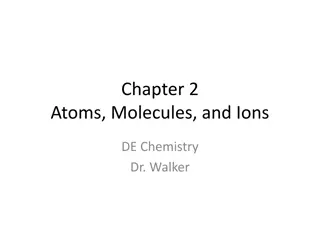Evolution of Atomic Theory: From Democritus to Thomson
Examine the evolution of atomic theory through the contributions of key scientists such as Democritus, Dalton, and Thomson. Explore the concept of subatomic particles, different models of the atom, and the impact of experiments on our understanding of the atom over time. From the solid sphere model to the discovery of electrons, this narrative showcases how scientific thought has progressed in unraveling the mysteries of the atom.
Download Presentation

Please find below an Image/Link to download the presentation.
The content on the website is provided AS IS for your information and personal use only. It may not be sold, licensed, or shared on other websites without obtaining consent from the author.If you encounter any issues during the download, it is possible that the publisher has removed the file from their server.
You are allowed to download the files provided on this website for personal or commercial use, subject to the condition that they are used lawfully. All files are the property of their respective owners.
The content on the website is provided AS IS for your information and personal use only. It may not be sold, licensed, or shared on other websites without obtaining consent from the author.
E N D
Presentation Transcript
Discovering the Atom (Chapters 4 and 5) Dr. Walker
Objectives Understand how experiments shaped our understanding of the modern atom: Subatomic particles (protons, neutrons, electrons) Models of the atom (solid sphere, planetary, quantum) Know scientists who contributed to atomic theory Democritus Dalton Thomson Rutherford Bohr
Chemistry Over Time Our understanding of the atom is based on experimental evidence, not conjecture Our understanding of the atom has changed over time based upon new evidence, and may continue to change All science is subject to peer review and repetition of experiments --- science deals with what can be proven!!
Democritus (460-370 BC) 200px-Demokrit Believed there had to be a basic building block of matter which could not be subdivided. A more famous philosopher, Aristotle, opposed this theory Called these building blocks atomos Greek for uncuttable or indivisible
John Dalton (1766-1844) John Dalton Credit with atomic theory Believed atoms were solid blocks (like a billiard ball) known as the solid sphere model
John Dalton Elements are made of tiny particles called atoms. The atoms of a given element are different from those of any other element; different elements can be distinguished by their distinct atomic weights. All atoms of a given element are identical. Atoms of one element can combine with atoms of other elements to form chemical compounds; a given compound always has the same relative numbers of types of atoms. In chemical reaction, atoms cannot be created, destroyed, or divided.
JJ Thomson (1856-1940) Sir Joseph John Thomson Performed cathode ray tube experiment, discovering the electron Pumped most of the air from a glass tube and applied a voltage to two electrodes placed at each end of the tube (1897) Anode---attached to positive terminal. Cathode attached to negative terminal.
JJ Thomson Thomson observed a glowing beam coming out of the cathode, striking the anode and the nearby glass walls of the tube. Called them cathode rays. The glass tube used by Thomson is known as a cathode-ray tube (CRT) which is currently used in television sets, computer monitors, and radar displays.
http://upload.wikimedia.org/wikipedia/commons/thumb/3/30/Cathode_ray_tube_-_neutral.svg/782px-Cathode_ray_tube_-_neutral.svg.pnghttp://upload.wikimedia.org/wikipedia/commons/thumb/3/30/Cathode_ray_tube_-_neutral.svg/782px-Cathode_ray_tube_-_neutral.svg.png
JJ Thomson Because he had pumped most of the air of the tube, the rays must have come from the cathode. Because the ray came from the negatively charged cathode, the ray must have been negatively charged. He confirmed his prediction by bending the cathode ray with a magnet.
JJ Thomson He also observed that when he placed a small paddle wheel in the path of the rays, the wheel turned. Something must ve been hitting the wheel---this suggested that the rays of the cathode were tiny particles that had mass. Later experiments with cathodes of different metals showed electrons were present in all atoms.
What did this mean? Atoms are uncharged, electrons have a negative charge. Scientists realized that there must be particles with a positive charge within the atom to balance the negative charge. Scientists also found that electrons are much less massive than atoms so other subatomic particles must exist.
JJ Thomsons Atomic Model Thomson proposed that electrons of the atom were embedded in a positively charged ball-of-matter, which led to the name plum-pudding model . http://www.doe.mass.edu/mcas/images/db/07chemHSq25.gif
Robert Millikan Performed experiments with charged oil drops Known (oddly enough) as the Millikan oil drop experiment Allowed him to calculate magnitude of charge of an electron 1.592 10 19Coulombs (unit of charge)
Robert Millikan https://cnx.org/contents/havxkyvS@9.419:mvoUPDqe@4/Evolution-of-Atomic-Theory#CNX_Chem_02_02_CathodeRay
Ernest Rutherford (1871-1937) Ernest Rutherford, 1st Baron Rutherford of Nelson Performed experiments (gold foil) disproving the plum pudding model of the atom (1909) Focused a beam of positively charged particles ( alpha particles ) at a thin gold foil. The team measured the angles at which the particles deflected after hitting the foil.
http://wps.prenhall.com/wps/media/objects/602/616516/Media_Assets/Chapter02/Text_Images/FG02_05.JPGhttp://wps.prenhall.com/wps/media/objects/602/616516/Media_Assets/Chapter02/Text_Images/FG02_05.JPG
Ernest Rutherford However, his team found that most of the particles went straight through the foil. Others went completely backwards. Rutherford s model didn t predict this---- Thomson s model had solid atoms and all of the atoms would have deflected. What happened in this experiment?
Ernest Rutherford The mass of this positively charge space, which he called the nucleus, must be larger than the mass of the alpha particle. Otherwise, the particle would have deflected rather than moving backward. The particles that went through the gold foil did so because most of the volume of the gold atoms were empty space (the electron cloud).
Okay From Rutherford s experiments, we know The nucleus has most of the mass of an atom The nucleus is positively charged The nucleus has protons and something else The atom is mostly empty space The plum-pudding model is invalid So now what does the atom look like???
Rutherfords Model Rutherford proposed: The nucleus is positively charged Electrons orbit around the nucleus Known as the nuclear model Rutherford s model was incomplete. It would later be expanded upon by Niels Bohr
Nuclear Model Notice there are no defined paths for the electrons .yet http://images.slideplayer.com/14/4379724/slides/slide_7.jpg
Niels Bohr Bohr expanded upon this theory by proposing Electrons travel only in successively larger circular orbits The outer orbits could hold more electrons than the inner ones, and that these outer orbits determine the atom's chemical properties
Planetary Model If opposite charges attract, what keeps the negatively charged electrons from moving into the positively charged nucleus?
The Solution Max Planck (1901) found that when matter is heated, it gives off energy at specific wavelengths. This energy is known as a quantum of energy These specific wavelengths mean that electrons can only exist at specific energy levels, like the rungs of a ladder. This led Bohr to the planetary model of the atom (1913)
Bohrs Planetary Model http://knowledgepublications.com/doe/images/DOE_Nuclear_Bohr_Model_of_the_Atom.gif https://reich-chemistry.wikispaces.com/file/view/180px-Stylised_Lithium_Atom_svg.png/31529697/180px-Stylised_Lithium_Atom_svg.png
The Quantum Model Bohr was the first to theorize the quantum model in a planetary arrangement Bohr s model = PLANETARY MODEL!! Bohr s original planetary arrangement didn t work (due to physics beyond the scope of this class) His idea only worked for hydrogen Electrons DO NOT move around the nucleus in fixed circular orbits Electrons ARE contained in discrete energy levels with distinct differences between them. You ve seen these in the electron configuration section.
The Quantum Model Louis de Broglie discovered that electrons act like waves (wave-particle duality) Matter acts like a particle (solid) AND a wave (radio waves, water) Frequencies of electrons correspond to the energy levels around the nucleus Werner Heisenberg is credited with the uncertainty principle Uncertainty principle we can t know EXACTLY where an electron is or how fast it s moving Both (along with Erwin Schrodinger) are credited with the discovery of the quantum model of the atom
Quantum Model http://js082.k12.sd.us/My_Classes/Physical_Science/atoms/atom-quantum.gif
Atomic Models Through Time Thomson model (Plum-Pudding) In the nineteenth century, Thomson described the atom as a ball of positive charge containing a number of electrons. Rutherford model In the early twentieth century, Rutherford showed that most of an atom's mass is concentrated in a small, positively charged region called the nucleus. Bohr model (Planetary) After Rutherford's discovery, Bohr proposed that electrons travel in definite orbits around the nucleus. Quantum mechanical model Modern atomic theory described the electronic structure of the atom as the probability of finding electrons within certain regions of space.
Terms to Know People Democritus Dalton Thomson Rutherford Millikan Planck Bohr deBroglie Heisenberg
Terms to Know Experiments Terms Solid sphere model Cathode ray tube experiment Plum pudding model Gold foil experiment Oil drop experiment Planetary model Quantum model Uncertainty principle




